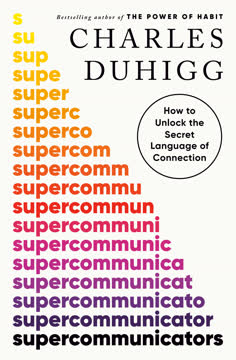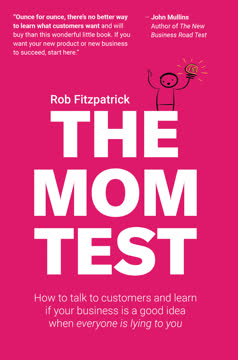النقاط الرئيسية
1. احتضان البساطة لفتح إمكانياتك
"نحن نولد ببساطة؛ نحن غريزيون وغير معقدين بشكل رائع؛ بدائيون."
اكتشف بساطة الطفولة من جديد. مع تقدمنا في العمر، نميل إلى تعقيد الأمور، مما نفقد معه الطبيعة الغريزية وغير المعقدة التي كنا نتمتع بها كأطفال. يمكن أن تعيق هذه التعقيدات إمكانياتنا لتحقيق النجاح والسعادة. من خلال إزالة الطبقات غير الضرورية والعودة إلى نهج أكثر بساطة، يمكننا فتح قدراتنا الحقيقية.
تحدَّ توقعات المجتمع. غالبًا ما يفرض المجتمع أن النجاح يجب أن يكون معقدًا وأنه لا يمكن تحقيقه إلا من قبل قلة مختارة. ومع ذلك، يمكن أن تكون هذه المعتقدات محدودة للذات. من خلال التساؤل عن هذه الافتراضات واحتضان عقلية أبسط، نفتح أنفسنا أمام إمكانيات جديدة وفرص للنمو.
بسط نهجك:
- ركز على المهام والأهداف الأساسية
- تخلص من المشتتات غير الضرورية
- ثق بغرائزك وقدراتك الطبيعية
- تعامل مع المشكلات من منظور جديد وغير معقد
2. تنمية الفضول وتحدي افتراضاتك
"البحث هو ما أفعله عندما لا أعرف ما أفعله." - فيرنهير فون براون
احتضان المجهول. الفضول هو دافع قوي للنجاح والنمو الشخصي. من خلال الحفاظ على شعور بالدهشة والسعي بنشاط نحو تجارب ومعرفة جديدة، يمكننا توسيع آفاقنا باستمرار واكتشاف فرص جديدة.
اسأل عن كل شيء. الأشخاص الناجحون لا يخشون تحدي افتراضاتهم الخاصة وتلك الخاصة بالآخرين. من خلال اعتماد عقلية تساؤلية، يمكننا التحرر من المعتقدات المحدودة واكتشاف حلول مبتكرة للمشكلات.
نمي فضولك:
- اسأل "لماذا" و"كيف" بشكل متكرر
- استكشف مواضيع خارج مجالك
- شارك في محادثات مع أشخاص من خلفيات متنوعة
- جرب أفكارًا ونُهجًا جديدة
- اعتبر الفشل فرصة للتعلم
3. إعادة صياغة المشكلات كفرص للنمو
"الفرق بين ما نفعله وما نحن قادرون على فعله يكفي لحل معظم مشاكل العالم." - المهاتما غاندي
غير منظورك. بدلاً من رؤية المشكلات كعقبات لا يمكن التغلب عليها، اعتبرها فرصًا للتعلم والنمو وإظهار قدراتك. يمكن أن تحول هذه النقلة في التفكير التحديات إلى خطوات نحو النجاح.
تحمل المسؤولية. بدلاً من إلقاء اللوم على العوامل الخارجية أو الشعور كضحية، تحمل مسؤولية إيجاد الحلول. هذه العقلية الاستباقية تمكنك من السيطرة على ظروفك ودفع التغيير الإيجابي.
استراتيجيات حل المشكلات:
- قسم المشكلات الكبيرة إلى مهام أصغر يمكن إدارتها
- ابحث عن حلول وطرق غير تقليدية
- تعاون مع الآخرين للحصول على وجهات نظر جديدة
- تعلم من الفشل والنجاحات السابقة
- احتفل بالانتصارات الصغيرة على طول الطريق
4. تطوير تركيز ثابت على أهدافك
"القادة العظماء هم دائمًا تقريبًا مبسطون عظماء." - كولن باول
وضوح الهدف. الأشخاص الناجحون لديهم رؤية واضحة لما يريدون تحقيقه ويحافظون على تركيز حاد على أهدافهم. يساعدهم هذا الالتزام الثابت في التنقل عبر التحديات والبقاء متحفزين في مواجهة الشدائد.
تخلص من المشتتات. حدد وأزل أي شيء لا يتماشى مع أهدافك. قد يتطلب ذلك قول "لا" لبعض الفرص، أو قطع الأنشطة التي تستهلك الوقت، أو إعادة هيكلة بيئتك لدعم أهدافك.
حافظ على التركيز:
- حدد أهدافًا محددة وقابلة للقياس وقابلة للتحقيق وذات صلة ومحددة زمنياً (SMART)
- أنشئ روتينًا يوميًا يركز على أهم مهامك
- استخدم تقنيات التصور لتعزيز أهدافك
- راجع أهدافك بانتظام واضبطها حسب الحاجة
- أحط نفسك بأشخاص داعمين يشاركونك رؤيتك
5. التحضير بعناية للنجاح
"من خلال الفشل في التحضير، أنت تحضر للفشل." - بنيامين فرانكلين
استثمر في نفسك. النجاح نادرًا ما يأتي بالصدفة. يتطلب تخطيطًا دقيقًا، وتعلمًا مستمرًا، وممارسة متعمدة. من خلال استثمار الوقت والجهد في تطوير مهاراتك ومعرفتك، تزيد من فرصك في تحقيق أهدافك.
أنشئ البيئة المناسبة. أحط نفسك بأشخاص وموارد وظروف تدعم طموحاتك. قد يتطلب ذلك البحث عن مرشدين، أو بناء شبكة دعم، أو إنشاء مساحة مادية ملائمة لعملك.
استراتيجيات التحضير:
- طور عقلية نمو واحتضان التعلم مدى الحياة
- خصص وقتًا محددًا لتطوير المهارات والممارسة
- أنشئ خطط طوارئ للعقبات المحتملة
- قيم تقدمك بانتظام واضبط نهجك حسب الحاجة
- اطلب تعليقات من مصادر موثوقة لتحديد مجالات التحسين
6. تنمية الثقة بالنفس والأصالة
"إذا سمعت صوتًا داخليًا يقول 'لا يمكنك الرسم'، فبكل الوسائل ارسم، وسيسكت ذلك الصوت." - فنسنت فان غوخ
نمي ثقتك بنفسك. الإيمان بنفسك وبقدراتك أمر حاسم للنجاح. تحدى الحديث السلبي عن الذات وركز على نقاط قوتك وإنجازاتك السابقة لبناء أساس قوي من الثقة بالنفس.
احتضان صفاتك الفريدة. لا تحاول أن تكون شخصًا آخر. الأصالة قوية وجذابة. من خلال كونك صادقًا مع نفسك، ستجذب الآخرين إليك بشكل طبيعي وتجد فرصًا تتماشى مع نقاط قوتك وشغفك الحقيقي.
بناء الثقة بالنفس:
- مارس الحديث الإيجابي عن الذات والتأكيدات
- احتفل بإنجازاتك، مهما كانت صغيرة
- أحط نفسك بأشخاص داعمين ومشجعين
- تحدى نفسك بمواجهة تحديات تدفعك خارج منطقة الراحة
- تعلم كيفية التمييز بين النقد البناء والسلبي غير المفيد
7. اتقن فن التواصل الفعال
"الطريقة التي نتواصل بها مع الآخرين ومع أنفسنا تحدد في النهاية جودة حياتنا." - توني روبينز
استمع بنشاط. التواصل الفعال هو طريق ذو اتجاهين. مارس الاستماع النشط من خلال منح انتباهك الكامل للآخرين، وطرح أسئلة توضيحية، والسعي لفهم وجهة نظرهم قبل الرد.
خصص رسالتك. ضع في اعتبارك جمهورك وقم بتكييف أسلوب تواصلك وفقًا لذلك. استخدم لغة واضحة وموجزة وكن واعيًا للإشارات غير اللفظية لضمان تلقي رسالتك كما هو مقصود.
استراتيجيات التواصل:
- مارس التعاطف وابحث عن فهم وجهات نظر الآخرين
- استخدم السرد لجعل نقاطك أكثر جاذبية ولا تُنسى
- طور ذكائك العاطفي للتنقل بشكل أفضل في الديناميات الشخصية
- تعلم كيفية تقديم واستقبال النقد البناء
- اتقن فن طرح الأسئلة القوية
8. استغل قوة التعاون
"وحدنا يمكننا أن نفعل القليل، معًا يمكننا أن نفعل الكثير." - هيلين كيلر
بناء شبكات قوية. نادرًا ما يتحقق النجاح في عزلة. قم بتنمية علاقات مع أفراد متنوعين يمكنهم تقديم وجهات نظر ومهارات وموارد مختلفة لدعم أهدافك.
تعزيز عقلية التعاون. كن منفتحًا على مشاركة الأفكار، ومنح الفضل حيث يستحق، والعمل نحو النجاح الجماعي. من خلال خلق بيئة من الدعم والثقة المتبادلة، يمكنك تحقيق أكثر مما يمكنك بمفردك.
استراتيجيات التعاون:
- ابحث عن مرشدين وكن مستعدًا لتوجيه الآخرين
- شارك في الشبكات والمجتمعات المهنية
- مارس الاستماع النشط والانفتاح في البيئات الجماعية
- استغل التكنولوجيا لتسهيل التعاون عن بُعد
- احتفل بنجاحات الفريق وتعلم من الإخفاقات الجماعية
9. بناء المرونة والمثابرة خلال التحديات
"النجاح ليس نهائيًا، والفشل ليس قاتلًا: الشجاعة للاستمرار هي ما يهم." - وينستون تشرشل
طور قوة عقلية. المرونة هي القدرة على التعافي من النكسات والاستمرار في الدفع للأمام. ازرع عقلية نمو ترى التحديات كفرص للتعلم والتحسين.
احتضان الفشل كمعلم. تحتوي كل نكسة على دروس قيمة. بدلاً من أن تشعر بالإحباط من الفشل، قم بتحليله بشكل موضوعي لاستخراج رؤى يمكن أن تفيد جهودك المستقبلية.
بناء المرونة:
- مارس تقنيات اليقظة وإدارة الضغط
- ضع توقعات واقعية واحتفل بالانتصارات الصغيرة
- طور نظام دعم للاعتماد عليه في الأوقات الصعبة
- حافظ على منظور طويل الأمد عند مواجهة تحديات قصيرة الأمد
- راجع بانتظام وتعلم من التجارب السابقة، سواء كانت نجاحات أو إخفاقات
10. عرّف النجاح وفقًا لشروطك الخاصة
"لفترة طويلة، تم تجاهل أولئك الذين هم بطبيعتهم هادئون، جادون أو حسّاسون. الأكثر ضجيجًا يتولون الأمر - حتى لو لم يكن لديهم ما يقولونه."
تحدَّ التعريفات المجتمعية. يبدو النجاح مختلفًا لكل شخص. قاوم الرغبة في قياس إنجازاتك وفقًا لمعايير الآخرين أو توقعات المجتمع. بدلاً من ذلك، عرّف ما يهمك حقًا ونسق أهدافك وفقًا لذلك.
أعط الأولوية للرفاهية. النجاح الحقيقي يتجاوز مجرد الإنجازات المهنية أو المكاسب المادية. اعتبر كيف تؤثر مساعيك على رفاهيتك العامة، وعلاقاتك، وإحساسك بالتحقق.
تعريف النجاح الشخصي:
- تأمل في قيمك الأساسية وما يجلب لك السعادة الحقيقية
- حدد أهدافًا تتماشى مع تعريفك الشخصي للنجاح
- راجع وأعد تقييم تعريفك بانتظام مع نموك وتغيرك
- احتفل بأشكال متنوعة من الإنجاز، وليس فقط المعالم التقليدية للنجاح
- اسعَ لتحقيق التوازن بين الإنجازات المهنية والإشباع الشخصي
آخر تحديث::
FAQ
What's "Simple Thinking: How to Remove Complexity from Life and Work" about?
- Simplification for Success: The book by Richard Gerver focuses on simplifying life and work to achieve success. It emphasizes that success is not about complexity but about understanding people, behaviors, and attitudes.
- Leadership and Simplicity: It draws on the idea that great leaders are simplifiers, as quoted by Colin Powell, and provides insights into how simplification can lead to effective leadership.
- Personal Development: The book is a guide for personal development, encouraging readers to reflect on their lives and remove unnecessary complexities to make success more attainable.
- Practical Advice: Through stories and reflections, Gerver offers practical advice on how to simplify thinking and actions to achieve personal and professional goals.
Why should I read "Simple Thinking: How to Remove Complexity from Life and Work"?
- Gain Clarity: The book helps readers gain clarity in their personal and professional lives by removing unnecessary complexities.
- Improve Leadership Skills: It provides insights into how simplification can enhance leadership abilities, making it a valuable read for aspiring leaders.
- Enhance Problem-Solving: Readers can learn to approach problems with a simplified mindset, leading to more effective and creative solutions.
- Inspiration and Motivation: The book is filled with motivational stories and quotes that inspire readers to pursue their goals with a simplified approach.
What are the key takeaways of "Simple Thinking: How to Remove Complexity from Life and Work"?
- Simplicity is Key: Success is not about complexity but about simplifying processes and focusing on what truly matters.
- Childlike Curiosity: Embrace a childlike curiosity and openness to new experiences to foster creativity and innovation.
- Focus and Belief: Maintain a clear focus on goals and believe in your ability to achieve them, despite obstacles.
- Collaboration and Communication: Effective collaboration and communication are essential for success, emphasizing the importance of listening and learning from others.
What are the best quotes from "Simple Thinking: How to Remove Complexity from Life and Work" and what do they mean?
- "Great leaders are almost always great simplifiers." This quote by Colin Powell, highlighted in the book, underscores the importance of simplification in leadership.
- "Success is not complicated; it doesn't have a secret formula." This emphasizes that success is about people, behaviors, and attitudes rather than complex strategies.
- "Any intelligent fool can make things bigger, more complex, and more violent." This quote by Ernst F. Schumacher, included in the book, suggests that true genius lies in simplifying and reducing complexity.
- "Success is peace of mind, which is a direct result of self-satisfaction in knowing you did your best." This quote by Jon Wooden, referenced in the book, highlights the internal satisfaction that comes from doing one's best.
How does Richard Gerver suggest we remove complexity from life and work?
- Focus on Essentials: Gerver advises focusing on what truly matters and eliminating distractions that add unnecessary complexity.
- Embrace Simplicity: He encourages adopting a mindset that values simplicity in processes and decision-making.
- Childlike Curiosity: By maintaining a childlike curiosity, individuals can approach problems with fresh perspectives and innovative solutions.
- Effective Communication: Simplifying communication by being clear and direct can help reduce misunderstandings and foster better collaboration.
What role does curiosity play in "Simple Thinking: How to Remove Complexity from Life and Work"?
- Curiosity as a Driver: Curiosity is seen as a key driver of success, encouraging individuals to explore new ideas and experiences.
- Childlike Perspective: The book emphasizes maintaining a childlike perspective, which allows for more creative and flexible problem-solving.
- Lifelong Learning: Curiosity leads to lifelong learning, which is essential for personal and professional growth.
- Overcoming Fixedness: By being curious, individuals can overcome functional fixedness and see beyond the obvious solutions.
How does Richard Gerver define success in "Simple Thinking: How to Remove Complexity from Life and Work"?
- Internal Satisfaction: Success is defined as internal satisfaction from knowing you did your best, rather than external measures like wealth or fame.
- Emotional Depth: It involves emotional depth and the ability to look back on one's efforts and feel they were worthwhile.
- Active Engagement: Success is about being actively engaged in life and taking responsibility for one's journey.
- Continuous Pursuit: It is a continuous pursuit rather than a final destination, driven by personal growth and learning.
What is the significance of collaboration in "Simple Thinking: How to Remove Complexity from Life and Work"?
- Enhances Success: Collaboration is essential for success, as it brings together diverse perspectives and skills.
- Mutual Respect: Successful collaboration is built on mutual respect and trust among team members.
- Organic Growth: It should be organic and evolve naturally, allowing for flexibility and innovation.
- Shared Experiences: Collaboration provides shared experiences that enrich personal and professional growth.
How does Richard Gerver address the concept of failure in "Simple Thinking: How to Remove Complexity from Life and Work"?
- Learning Opportunity: Failure is seen as a learning opportunity and a stepping stone to success.
- Resilience and Perseverance: The book emphasizes the importance of resilience and perseverance in overcoming failures.
- Reframing Failure: By reframing failure as a natural part of the journey, individuals can maintain motivation and continue pursuing their goals.
- Success Stories: The book includes success stories of individuals who overcame failures to achieve their aspirations.
What advice does Richard Gerver give on maintaining focus in "Simple Thinking: How to Remove Complexity from Life and Work"?
- Clear Goals: Maintain clear goals and a strong sense of purpose to stay focused on what truly matters.
- Avoid Distractions: Identify and avoid distractions that can derail progress towards achieving goals.
- Present Moment: Focus on the present moment and the task at hand, rather than dwelling on the past or worrying about the future.
- Self-Discipline: Develop self-discipline to stay committed to goals and resist the temptation to deviate from the path.
How does "Simple Thinking: How to Remove Complexity from Life and Work" address the importance of self-belief?
- Controlling the Inner Voice: The book discusses the importance of controlling the inner voice that can undermine self-belief.
- Recognizing Strengths: It encourages individuals to recognize their strengths and use them to build confidence.
- Overcoming Doubt: By overcoming self-doubt, individuals can pursue their goals with greater determination and resilience.
- Empowerment: Self-belief empowers individuals to take risks and embrace challenges as opportunities for growth.
What practical steps does Richard Gerver suggest for simplifying communication in "Simple Thinking: How to Remove Complexity from Life and Work"?
- Active Listening: Emphasize active listening to understand others and foster effective communication.
- Authenticity: Be authentic in communication, ensuring that messages are genuine and sincere.
- Clarity and Directness: Use clear and direct language to convey messages without ambiguity.
- Empathy and Understanding: Demonstrate empathy and understanding to build rapport and trust with others.
مراجعات
تتلقى "التفكير البسيط" آراء متباينة، حيث حصل على تقييم متوسط يبلغ 3.54 من 5. يجد بعض القراء فيه إلهامًا ومساعدة في تبسيط الحياة، مشيدين بأسلوبه الكتابي السهل ونصائحه العملية. يثمنون التركيز على الفضول والقدرة على التكيف والأصالة. بينما ينتقد آخرون الكتاب لافتقاره إلى العمق، واعتماده بشكل مفرط على القصص الشخصية، وعدم تحقيقه لوعده. وقد وجد بعض القراء أن التشبيهات فيه مربكة أو غير جذابة. بشكل عام، يبدو أن الكتاب يلقى صدى لدى أولئك الذين يسعون إلى التحفيز ووجهات نظر جديدة في تطوير الذات.
Similar Books











